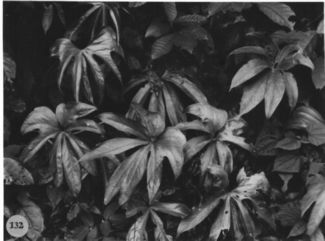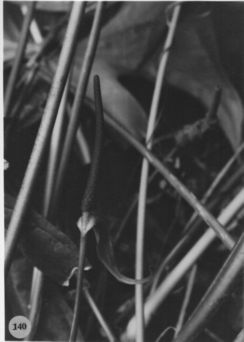


Anthurium pedatoradiatum ssp. helleborifolium (Schott) Croat, comb. nov.
Anthurium helliborifolium Schott, Bonplandia 10: 148. 1862. TYPE: Mexico. No specimen cited in original description (F, hololectotype, FM 29818; Photo of cultivated plant prepared by Schott here designated).
Terrestrial; ca. 1 m or less tall; stems thick, 9-25 cm long, 2-3 cm diam.; internodes very short; leaf scars 2 cm wide, usually obscured by cataphylls; roots medium thick, descending; cataphylls subcoriaceous, 2.5-5.3 cm long, sometimes tinged reddish, drying medium brown (B & K Yellow 5/5), splitting at base, remaining intact at apex, persisting around stem.
LEAVES with petioles erect, (27)48-56(63) cm long, 8-9 mm diam., terete; geniculum 1-1.7 cm long; blades, 7-11 pedatisect, moderately thick, broadly ovate in outline, deeply lobed at base, 27-33.5 cm long, 18-48 cm wide, broadest at middle or just below; the lobes free or nearly so to base, the outermost lobes confluent to a greater degree, sometimes falcate, acuminate at apex, the median lobe 21-27 cm long, 5.7-7.9 cm wide, broadest just above middle, outermost lobes 12-18 cm long, markedly inequilateral and usually auriculate; sinus narrowly to broadly spathulate to hippocrepiform, acute to rounded at apex; the upper surface glossy, lower surface semiglossy; the midrib of the median lobe acutely raised above, diminished and sunken at apex, raised below; primary lateral veins 3-4, departing midrib at 40°-50° angle, sunken and nearly obscure above, raised below; basal veins 5-6 pairs, the first and second free to base, the remaining coalesced 1.5-4 cm, raised above and below; the posterior ribs weakly curved, naked ca. one half their length; collective vein arising near the base of lobe, or from one of the primary lateral veins near middle, 1-5 mm from margin.
INFLORESCENCE erect, shorter than leaves; peduncle (8)20-30 cm long, 3-5 mm diam., terete; spathe moderately thin, green, lanceolate, 5.5-11 cm long, 0.6-1.5 cm wide, gradually acuminate at apex, rounded at base, inserted at ca. 45° angle on peduncle; spadix green (B & K Yellow-green 5/7.5), 4-8 cm long, 4-6 mm diam. at base, 2-3 mm diam. at apex; the flowers rhombic to sub-4-lobed, 2.5-3 mm long, 2.8-3.2 mm wide, the sides smoothly sigmoid; 3-5 flowers visible in the principal spiral, 4-6 flowers visible in the alternate spiral; tepals matte, densely papillate, lateral tepals 1-1.5 mm wide, the inner margin straight; pistils emergent, only slightly raised, green, densely papillate; stigma linear, 4-5 mm long, dark slit with red-violet punclations; stamens emerging from the base, lateral stamens preceding alternates by 1-2 spirals, exserted on long, translucent filaments, 0.5-0.8 mm long, 0.9-1 mm wide, retracting to hold stamens at edge of pistil; anthers yellow to tan, sometimes deep purple; thecae ellipsoid, somewhat divariate; pollen cream to yellow.
INFRUCTESCENCE not seen. Figs. 132, 133,
and 140.
Anthurium pedatoradiatum ssp. helleborifolium is endemic to southern
Mexico in Chiapas and Tabasco where it is common in "selva alta perennifolia"
in the vicinity ofTeapa, Tabasco. All collections seen were made at elevations
of less than 300 m. Plants are terrestrial, commonly well rooted in the soil
but generally on well drained soil, usually over porous limestone, commonly
on rocky slopes.
Anthurium pedatoradiatum ssp. helleborifolium differs from ssp.
pedatoradiatum in having 1-3 of the medial blade segments free or
nearly free to the base. In addition, those collections of ssp. helleborifolium
grown side by side in the greenhouses with ssp. pedatoradiatum have consistently
darker green, thicker leaves. Madison (1978) treated ssp. helleborifolium
as synonymous with A. pedatoradiatum but I feel they are separable at
least at the subspecific level. All of the material observed thus far has been
easily separable on the key characters although some specimens with a poor state
of preservation appeared to have free segments because of torn segments. A collection
of Bunting and Davies (117) collected near Teapa was deemed intermediate
by Bunting (1965) who reported that it differed in "having the outline
of the former but with the central lobe free to the very base." I have
found that the outline of the leaf blades of the species are very generally
the same and the division of the leaf blade of the Bunting and Davies specimen
is well within the range of variation for the species.
Since no type specimen was cited I have selected as a lectotype a collection
prepared and annotated by H. C. Schott from a cultivated plant in Vienna. Although
the specimen itself has been destroyed, the photographs of the specimen are
widely distributed as Field Museum plate #29818.
 |
 |
 |
Map of Mesoamerican specimens with coordinates
Mexico Chiapas: 80 m,, 3 July 1977, Thomas B. Croat 40081 (MO).